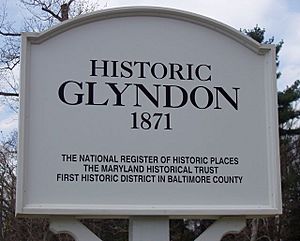Glyndon, Maryland facts for kids
Glyndon is a small community in Baltimore County, Maryland, USA. It was started in 1871 by Dr. Charles A. Leas. Glyndon is in the northwest part of Baltimore County. It's mostly a place where people live, close to the big city of Baltimore City. Glyndon is a historic place! It was added to the National Register of Historic Places in 1973. The Glyndon Historic District was also the first historic area named in Baltimore County in 1981.
Contents
Glyndon's Early Days
The town of Glyndon began to grow when the Western Maryland Railway arrived in 1860. This train line made it easier for people to travel.
Before 1871, a man named Dr. Charles A. Leas bought a lot of land here. He was the first health officer for Baltimore City. He decided to create a small town. He hired Augustus Bouldin to plan the streets and lots. They even planted rows of maple trees along the roads! Samuel P. Townsend, another businessman, also helped Glyndon grow. He bought and developed many acres. He was a merchant, a railroad agent, and the postmaster.
Summer Homes and Town Life
Rich people from Baltimore bought summer homes in early Glyndon. They wanted to escape the hot city. The train made it easy for them to travel to their jobs in the city, about 25 miles away. Most homes were two or three stories tall. They had big, airy rooms, wide hallways, and large porches. These were perfect for summer living. Some boarding houses also let city people stay in the country during the summer.
A small business area grew near the train station. It served the people living in Glyndon. Along Railroad Avenue, there was a post office, a general store, a town hall, a blacksmith shop, and an ice cream parlor. On Chatsworth Avenue, you could find another general store, a bakery, a butcher shop, and a carpenter.
Historic Places and Churches
The Western Maryland Railway and a streetcar line also brought summer visitors to Emory Grove. This was a Methodist religious camp started in 1868.
Near Glyndon is Glyndon Park, started in 1887. It was a special camp for people who wanted to avoid alcohol. It was the first of its kind south of the Mason and Dixon's Line.
In 1878, the Glyndon United Methodist Church was built. The first wooden church burned down in 1929. The stone church you see today was finished in 1931. Sacred Heart Church also began in 1873. It was built using marble from a nearby quarry.
Schools in Glyndon
There were two schools in the Glyndon area. St. George's Hall was a private boarding school for boys. It was started in 1876. The first building burned down in 1896, but a new one was built.
The Glyndon School on Butler Road was a public school. It was built in 1887 for the growing number of children living in Glyndon all year. This school closed in 1930. In 1932, it became the home of the Woman's Club of Glyndon. This club started in 1898 when some ladies met on a porch to read together.
Glyndon's Location
Glyndon is located at 39.4764935 degrees North and 76.8158100 degrees West. It is about 689 feet above sea level. Butler Road is the main road through the community.
Education
Public Schools
Children in Glyndon attend schools in the Baltimore County Public Schools system. These include:
- Franklin Elementary, Glyndon Elementary (opened 1978)
- Franklin Middle
- Franklin High
Famous People from Glyndon
- Dr. Charles A. Leas was the founder of Glyndon. His old home, which is over 200 years old, is one of the oldest in Glyndon.
- Thomas Rowe Price Jr. was born in Glyndon in 1898. He grew up here. He later founded a big investment company called T. Rowe Price.


